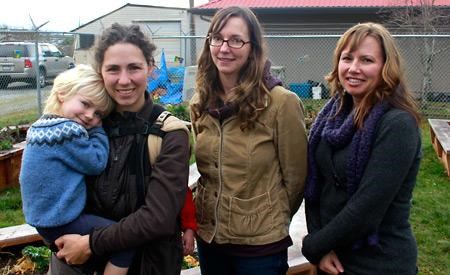Master gardeners, landscape designers and parents attended a workshop to help an elementary school transform its traditional playground into a learning schoolyard.
Dolores Atlin from Evergreen, a Canadian organization helping to bring nature into urban areas, recently presented the workshop.
Discover Imagine Grow Schoolyard (DIGS) is an initiative led by parents of students at James Thomson Elementary School together with the school’s administration.
James Thomson is in need of a new playground and has received money from the provincial government to upgrade its school yard. Additionally, the Parent Advisory Committee (PAC) at the school has been raising money for playground upgrades and is on board with DIGS’ plans.
DIGS is forming a conceptual plan for the whole schoolyard and breaking it up into smaller projects that can be completed in phases as funding becomes available.
“We’ve identified different zones by looking at the geography of the landscape and what activities the kids do in those areas,” said Dr. Leta Burechailo, an organizer with DIGS.
The concept is to keep the swings and slides, but also include spaces for more interactive, imaginative play and outdoor classrooms.
“The idea isn’t that we’re purchasing things to put in,” said principal Jasmin Marshman, “it’s changing the landscape that’s already there.”
The plan is also to include elements of Tla’amin (Sliammon) First Nations’ culture into the design and to tie the project into the environmental aspects of the school’s eco-immersion program.
Gail Blaney is an aboriginal educator at James Thomson and she thinks that growing indigenous plants in the schoolyard would help better connect students to their local environments. The plan includes building areas for outdoor classrooms which may be as simple as creating a ring of larger rocks or stumps for students to sit on to hear stories from their teachers and Tla’amin elders.
“Instead of just having a swing there will be little nooks and crannies for playing hide and seek or pretending,” said Francine Ulmer, a member of DIGS. “It’s about making a landscape for imaginative play.”
One of the main themes children brought up over and over again is that they want a space to chill out, said Jon van Oostveen, a member of DIGS.
“There aren’t many spaces for them to just be able to hang out with a friend or by themselves if they’re having a rough day,” he said.
Marshman said her students are most excited after a windstorm because branches fall from the tall evergreen trees in the schoolyard and the students find imaginative uses for them.
“They know they can build something with the branches,” said Marshman. “They know that they only have a certain amount of time before maintenance clears the branches away.” Once they’re cleaned up the students go back to the monkey bars and the slide, she said.
“It would be great if they had the opportunity to have area for imaginative play all the time,” said Marshman.



